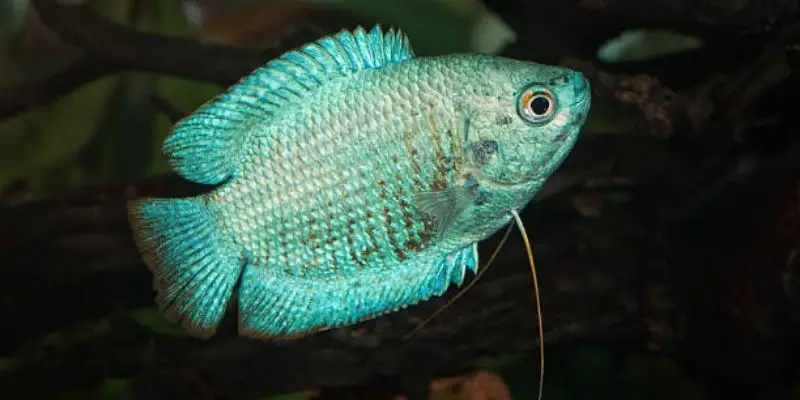Many new fish keepers have beautiful blue gourami in their tank and are wondering why it is being so aggressive.
This can be a common issue with this type of fish, but there are ways to help curb the behavior.
In this post, we’ll take a look at what might be causing your blue gourami to act out and some tips on how to deal with it.
Blue Gouramis and Aggression
Blue gouramis can be incredible fish, adding great diversity to the tank. Unfortunately, these fish are often incorrectly labeled as “peaceful” or “community” fish when in fact they should not share their tank with others.
The blue gourami is a territorial fish that can be very aggressive when it comes to establishing its territory.
It might stake out certain areas of the tank, especially near where food is dropped and will chase away any other fish that come too close.
Blue Gouramis in Action
Blue gouramis are also known for being able to breathe air from the surface of the water.
Just like betta fish, they have a labyrinth organ that allows them to take in oxygen from above the surface rather than through their gills.
This makes them incredibly hardy and able to survive in small spaces without much oxygen (like inside your filter or pump).
These behaviors can make it difficult to keep blue gouramis with other fish.
On the other hand, some aquarists enjoy the beautiful contrast of their bright blue color along with plants and driftwood in an aquarium.
So…
Why Are☻ These Fish So Aggressive?
Blue gouramis are very protective of their territory. This is especially true for male gouramis, who will fight with any male that comes into their area.
They’ll also chase away other “intruders” including females and even young fry.
So what does this mean? If you’re expecting to put female blue gourami in with your male, it’s not going to happen!
Even if the female is in the tank first, she will likely be chased away or killed.
The blue gourami can also become very aggressive when it comes to food – if another fish comes too close after your blue gourami finishes its meal, there could be trouble!
How to Help Your Blue Gourami Cope
Blue gouramis are difficult to care for, especially when it comes to tank mates. But they aren’t impossible!
If you’re interested in keeping blue gourami, here are some things you’ll want to keep in mind:
- Don’t house more than one male blue gourami per tank. Two males will fight and tear each other apart.
- If you choose to keep a female blue gourami or multiple blue gouramis, be sure there is plenty of space and hiding places for everyone! -Remember that your blue gourami requires plenty of space and oxygen. Try not to overcrowd the tank and don’t position it near filters (which reduce the oxygen supply).
- Blue gouramis are very active – be sure to provide them with plenty of space to swim.
- Make sure your blue gourami has a diet rich in protein, including brine shrimp, bloodworms, and even small insects like crickets!
With proper care, your beautiful blue gourami can bring a great deal of joy to your tank.
Just keep in mind that these fishes are best kept alone. Keeping a male and female blue gourami together is almost always a death sentence for the female!
Good News for Blue Gouramis
While they can be aggressive, it does not mean they have to stay lonely forever. You just have to know how to properly house them.
If you are looking for blue gourami tank mates, there are actually quite a few fish that can live with them peacefully.
What Fish Can Live with Blue Gouramis?
There are several types of fish that can live peacefully with your blue gourami. Many aquarists have had success keeping the following types of fish with their blue gouramis:
Molly ( Poecilia sphenops )
There is some debate over whether mollies and other livebearers can safely coexist. Molly females are usually chased away by larger fish like the blue gourami, but it’s said that males sometimes form non-aggressive “buddies” with other fish.
Rosy Barb ( Puntius conchonius )
According to many aquarists, the rosy barb is among one of the best tank mates for blue gouramis because it stays small and doesn’t nip at their long fins. They do not share any similar water requirements so it is fairly easy to care for them together.
Cardinal Tetra ( Paracheirodon axelrodi )
The cardinal tetra is the most popular fish available, but since it’s very peaceful, many aquarists keep them with blue gouramis without any issues. With their bright red color against the blue gourami, they make for a stunning addition to any freshwater tank.
Harlequin Rasbora ( Trigonostigma heteromorpha )
The Harlequin rasbora is another peaceful fish that can live safely with your blue gourami. It will not be chased away by the blue gourami and is usually safe with most other types of fish.
Fire Rasbora ( Trigonostigma espei )
While some say that the fire rasbora can be tamed by the blue gourami, others disagree due to its tiny size (it grows to only about 1.5 inches long) – it’s not fully known how safe this fish is, so research carefully before trying to keep it with your blue gourami.
Plecostomus ( Hypostomus plecostomus )
The Plecostomus is incredibly common in the wild and does not pose any threat to your blue gouramis provided they are introduced at the same time. Some aquarists have even successfully combined them with Gourami and other L-number fish!
Guppies ( Poecilia reticulata )
This is one of the most popular and safest species because they typically grow to only about 2.5 inches long. They will not be chased around by the blue gourami and it’s generally safe to keep them with other fish too.
Swordtails ( Xiphophorus helleri )
As long as the tank is large enough, swordtails can be kept with almost any species of fish without problems. They will not be attacked by the blue gourami if they are introduced simultaneously.
White Cloud Mountain Minnow ( Tanichthys albonubes )
The white cloud is a very peaceful fish, so long as you don’t keep too many of them in the tank. They are also an active species of fish, so it’s best to provide them with more space to swim around.
Harlequin Rasbora ( Trigonostigma heteromorpha )
Just like the Harlequin rasboras, some have had success keeping them with blue gouramis while others have not. Make sure to research carefully before trying to keep them together.
Dwarf Gourami ( Colisa lalia )
Because the blue gourami is generally more aggressive, they may not bother the dwarf gourami too much. Like most fish, they are best kept in a smaller school of six or more to make them feel safe and comfortable.
Verdict:
Some fish species are definitely safe for your blue gourami (the Plecostomus, Guppies, White Cloud Mountain Minnow), but others may be too small or too active to coexist peacefully (Cardinal Tetra). Research the species you plan on keeping with your blue gourami carefully before adding them to the tank!

